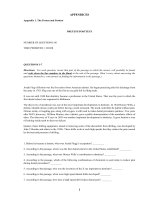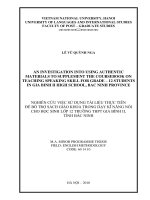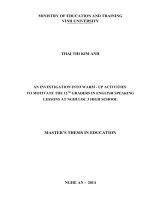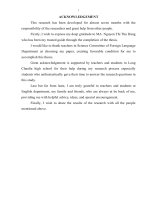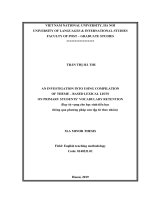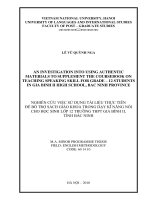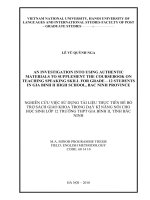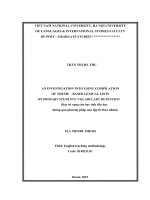AN INVESTIGATION INTO USING AUTHENTIC MATERIALS TO SUPPLEMENT THE COURSEBOOK ON TEACHING SPEAKING SKILL FOR GRADE – 12 STUDENTS IN GIA BINH II HIGH SCHOOL, BAC NINH PROVINCE
Bạn đang xem bản rút gọn của tài liệu. Xem và tải ngay bản đầy đủ của tài liệu tại đây (874.79 KB, 76 trang )
VIETNAM NATIONAL UNIVERSITY, HANOI
UNIVERSITY OF LANGUAGES AND INTERNATIONAL STUDIES
FACULTY OF POST – GRADUATE STUDIES
LÊ VŨ QUỲNH NGA
AN INVESTIGATION INTO USING AUTHENTIC
MATERIALS TO SUPPLEMENT THE COURSEBOOK ON
TEACHING SPEAKING SKILL FOR GRADE – 12 STUDENTS
IN GIA BINH II HIGH SCHOOL, BAC NINH PROVINCE
NGHIÊN CỨU VIỆC SỬ DỤNG TÀI LIỆU THỰC TIỄN
ĐỂ BỔ TRỢ SÁCH GIÁO KHOA TRONG DẠY KĨ NĂNG NÓI
CHO HỌC SINH LỚP 12 TRƯỜNG THPT GIA BÌNH II,
TỈNH BẮC NINH
M.A. MINOR PROGRAMME THESIS
FIELD: ENGLISH METHODOLOGY
CODE: 60 14 10
HÀ NỘI – 2010
VIETNAM NATIONAL UNIVERSITY, HANOI
UNIVERSITY OF LANGUAGES AND INTERNATIONAL STUDIES
FACULTY OF POST – GRADUATE STUDIES
LÊ VŨ QUỲNH NGA
AN INVESTIGATION INTO USING AUTHENTIC
MATERIALS TO SUPPLEMENT THE COURSEBOOK ON
TEACHING SPEAKING SKILL FOR GRADE – 12 STUDENTS
IN GIA BINH II HIGH SCHOOL, BAC NINH PROVINCE
NGHIÊN CỨU VIỆC SỬ DỤNG TÀI LIỆU THỰC TIỄN
ĐỂ BỔ TRỢ SÁCH GIÁO KHOA TRONG DẠY KĨ NĂNG NÓI
CHO HỌC SINH LỚP 12 TRƯỜNG THPT GIA BÌNH II,
TỈNH BẮC NINH
M.A. MINOR PROGRAMME THESIS
FIELD: ENGLISH METHODOLOGY
CODE: 60 14 10
SUPERVISOR: TÔ THỊ THU HƯƠNG, Ph.D
HÀ NỘI – 2010
TABLE OF CONTENT
i
LIST OF TABLES AND CHART
v
ABSTRACT
vi
ACKNOWLEDGEMENT
vii
PART I: INTRODUCTION
1
1. Rationale
1
2. The scope of the study
2
3. The research question and objectives of the study
2
4. Significance of the study
3
5. Methods of the study
3
6. Design of the study
3
PART II: DEVELOPMENT
4
CHAPTER I. LITERATURE REVIEW
4
I. 1. Approaches of Language Teaching
4
I. 1. 1. The Grammar – Translation Method
4
I. 1. 2. The Direct Method
5
I. 1. 3. The Audio – Lingual Method
6
I. 1. 4. Communicative Language Teaching
7
I. 1. 5. Conclusion
9
i
I. 2. Authentic Materials and Coursebook
9
I. 2. 1. Authentic Materials
9
I. 2. 1. 1. Definition
9
I. 2. 1. 2. Advantages of Using Authentic Materials
11
I. 2. 1. 3. Disadvantages of Using Authentic Materials
12
I. 2. 2. The Coursebook
12
I. 2. 2. 1. Definition
12
I. 2. 2. 2. Textbook Evaluation
13
I. 2. 2. 3. Textbook Adaptation
14
I. 2. 3. Conclusion
15
CHAPTER II. THE STUDY
16
II. 1. The Status of Teaching and Learning Speaking at Gia Binh II High School
16
II. 1. 1. Description of the Students at Gia Binh II High School
16
II. 1. 2. Description of the Teachers at Gia Binh II High School
16
II. 1. 3. The Status of Teaching and Learning Speaking at Gia Binh II High School
17
II. 2. Research Methodology
18
II. 2. 1. Questionnaire for the Teachers
18
II. 2. 2. Questionnaire for the Students
19
II. 3. Data Analysis
21
ii
II. 3. 1. Questionnaires for the Teachers
21
II. 3. 1. 1. Teachers’ Teaching Experience (Part I)
21
II. 3. 1. 2. Teachers’ Perceptions of CLT (Part II, Section A)
21
II. 3. 1. 3. Difficulties in teaching and learning speaking skill in terms of
23
coursebook (Part II, Section B – 1)
II. 3. 1. 4. Difficulties in teaching and learning speaking skill in terms of learners
24
(Part II, Section B –2)
II. 3. 1. 5. Difficulties in teaching and learning speaking skill in terms of facilities
26
(Part II, Section B – 3)
II. 3. 1. 6. The using of Authentic Materials for teaching English speaking skill
27
(Part II, Section C)
II. 3. 2. Questionnaires for the Students
29
II. 3. 2. 1. Students’ experience in learning English (question 1)
29
II. 3. 2. 2. Students’ attitude towards learning English and learning speaking skill
29
(question 2, 4, 5)
II. 3. 2. 3. Students’ motivation in learning English (question 3)
30
II. 3. 2. 4. Students’ evaluation of an English speaking lesson (question 6)
30
II. 3. 2. 5. Students’ difficulties in learning speaking skill (question 7)
31
II. 3. 2. 6. Students’ evaluation of using supplementary materials in speaking
32
iii
class (question 8, 9, 10)
II. 3. 2. 7. Students’ evaluation of teachers’ speaking skill (question 11)
33
II. 3. 2. 8. Students’ suggestions for better speaking teaching and learning
(question 12)
33
CHAPTER III. FINDINGS AND RECOMMENDATIONS
34
III. 1. Findings
34
III. 1. 1. Findings from Questionnaire for the Teachers
34
III. 1. 2. Findings from Questionnaire for the Students
35
III. 2. Recommendations
36
III. 2. 1. Recommendations for the Students
36
III. 2. 2. Recommendations for the Teachers
37
PART II. CONCLUSION
39
I. Conclusion.
39
II. Suggestions for Further Research.
40
REFERENCES
I
APPENDICES
VI
APPENDIX A: Survey Questionnaire for the Teachers
VI
APPENDIX B: Survey Questionnaire for the Students
XVII
APPENDIX C: Survey Questionnaire for the Teachers (the 1st version)
XXI
iv
LIST OF TABLES AND CHART
Table 1: Teachers’ age
21
Table 2: Teachers’ teaching experience
21
Table 3: Teachers’ Perceptions of CLT
22
Chart 1: Coursebook Evaluation of the Teachers
23
Table 4: Difficulties in teaching and learning in terms of learners
25
Table 5: Difficulties in teaching and learning in terms of facilities
26
Table 6: Perceptions of Authentic Materials
27
Table 7: Kinds of Authentic Materials often used
27
Table 8: Kinds of Activities used to develope speaking lessons
28
Table 9: Students’ motivation in learning English
30
Table 10: Students’ evaluation of an English speaking lesson
30
Table 11: Students’ difficulties in learning speaking skill
31
Table 12: Students’ evaluation of kinds of authentic materials used
32
Table 13: Students’ evaluation of kinds of activities used
32
Table 14: Students’ evaluation of teachers’ speaking skill
33
Table 15: Students’ suggestions for better speaking teaching and learning
33
v
PART I: INTRODUCTION
1. Rationale
Among the most popular languages of the world, English is the most universal
and has been used by more users than ever. The need of learning English always
increases and never stops. In Vietnam, foreign language learning and teaching
generally and English learning and teaching particularly have been granted increasing
supports from government, educational authorities for the demand of young labor force
with a good command of English in this present time of globalization.
To keep pace with the demand of English in our society, learners’
communicative competence significantly becomes more and more important and the
change of teaching method become an urgent requirement in order to help learners
obtain communicative competence. Years ago, the major methods used to teach
English in Vietnam were grammar – translation, audio – lingual… which were teachercentered, in which the teachers were the leaders, the controllers, the testers, etc…, and
the students were just the passive objects of the process of teaching and learning. The
index of how good a student was based on his/ her mastery of language structures
rather than on his/ her language use in reality, which then has been proved to be
inappropriate in the new time. Everything has changed with the appearance of the
approach communicative language teaching which really helps students get
communicative competence. One evidence of this development in Vietnam is the
reformation in both textbooks and methodologies done many times over decades in
order to ultimately find out a way of teaching and learning which best suits Vietnamese
students. In 2005, Ministry of Education and Training again introduced two new sets of
textbook, one for regular students (which is called as the standard textbook), and one
for specialized students with lots of revolutionary changes in comparison with
textbooks of English in the past.
The new English Textbook series written by Vietnamese writers pay more
attention on developing students’ communicative skills – Speaking, Listening, Writing
and Reading – and help students review grammatical rules in Language Focus. Task –
based lessons are the formation of the textbook. The tasks can be either pair work,
1
group work or class work, which give students more chances to take part in the lessons
to gradually develop their communicative competence, and make them the center of the
teaching and learning process. However, with such changes, there are still some
problems. “Although the new textbooks emphasize the students' communicative skills
in English, it is observed that classroom teaching remains grammar-focused, textbookbound, and teacher-centered on account of teachers' inadequacy of required proficiency
in English and teaching skills as well as of the traditional image of the teacher as a type
of omniscient authority figure and a holder of all knowledge.” (Le, V. C., 2007).
Furthermore, some parts of the textbook’s content are different from real life in
Vietnam, espeacially in rural areas, which make teaching and learning challenging.
Lesson adaptation becomes inevitable.
From all the things mentioned above, I would like to devote my time and effort
to: (1) investigate the current situation of teaching and learning English speaking skill
of grade-12 students in Gia Binh II High School, Gia Binh District, Bac Ninh Province;
(2) study how the new textbook is perceived by English teachers in Gia Binh II High
School and their grade-12 students; and (3) investigate how the teachers adapt the
lessons to make them suitable for students and whether or not they use authentic
materials to supplement their lessons while teaching speaking.
2. The scope of the study
The study focuses on how to use authentic materials to supplement the textbook
in teaching speaking skill to grade-12 students in Gia Binh II High School (GB II HS),
Gia Binh District, Bac Ninh Province.
3. The research question and objectives of the study
The main question to guide the current study is: How teachers use authentic
materials to supplement the textbook in teaching speaking skill to grade-12 students
in Gia Binh II High School, Gia Binh District, Bac Ninh Province?
Answers to this question help achieve the following three objectives:
To investigate the difficulties in teaching and learning speaking skill of teachers
and grade-12 students in Gia Binh II High School, Bac Ninh Province.
2
To investigate the problems of textbook faced by the teachers and grade-12
students in Gia Binh II High School, Gia Binh District, Bac Ninh Province.
To investigate the use of authentic materials to supplement the textbook in
teaching and learning speaking skill in the target school.
4. Significance of the study
This study hopefully hastens the change of English teaching methodology in
Gia Binh II High School by making teachers more aware of the significance of
authentic materials and use them in teaching English in general and teaching speaking
skill in particularly.
5. Methods of the study
This study is decided as a descriptive study. The instrument of data collection is
survey questionnaire. There are two questionnaires designed: one for teachers and one
for students. The questionnaires for the teachers were delivered to 10 English teachers
in GB II HS and 20 other teachers from Gia Binh I High School and Luong Tai I High
School which share quite the same conditions as my school. The questionnaire for
students were delivered to 130 students of four different classes A1, A2, A4 and A8 in
Gia Binh II High School. The data help to answer the research questions raised above.
6. Design of the study
The thesis consists of three parts:
Part I is the Introduction, which presents the rationales, the scope, the
objectives, the significances, the method and the design of the study.
Part II is the backbone of the thesis with three chapters: Chapter I deals with the
Literature Review, in which we review some approaches of teaching English in history
so far, the theories about textbook evaluation and textbook adaption, and the
application of authentic materials to supplement textbook in teaching a language.
Chapter II presents the methodology of the study and the data analysis. Chapter III
discusses the findings and proposes some suggestions for using authentic materials
while teaching to supplement the textbook.
Part III is the Conclusion and Suggestions for further research.
3
PART II. DEVELOPMENT
CHAPTER I. LITERATURE REVIEW
I. 1. Approaches of Language Teaching
I. 1. 1. The Grammar – Translation Method
Rooted in the formal teaching of Latin and Greek, Grammar – Translation
Method (GTM) was the dominant method in language teaching until the end of the 19th
century and continued to be used so far. However, it has long been believed to be old –
fashioned. According to Richards & Rodgers (1986: 3), this method has some principle
characteristics as follow: (1) It is a way of studying through detailed analysis of its
grammar rules and translation of sentences and texts into or out of the target language.
(2) Reading and writing are the major focus. Little or no attention is paid to listening
and speaking. (3) Vocabulary is taught through bilingual word lists, dictionary study
and memorization. (4) The sentence is the basic unit of teaching and practicing the
language. (5) Accuracy is emphasized. (6) Grammar is taught deductively. And (7) the
students’ mother tounge is the medium of instruction.
Talking about this method, Larsen-Freeman (1986: 11 - 12) supposed that the
“fundamental purpose of learning a foreign language is to be able to read literature
written in the target language”. Besides, according to her excerpt for 7 characteristics
above, teachers’ and learners’ role are also very important in GTM. Teachers are the
“authority” of the class, whereas the learners are just the listeners and followers.. That
makes up a picture of a one –way road, from the teachers to the students, little or even
no creativeness or interaction at all.
Another famous methodologist, Rivers W., also stated in her writing (1981: 31):
“There is much stress on knowing rules and exceptions, … little stress is laid on
accurate pronunciation and information; communication is neglected”. Certainly, the
stress on rules or accuracies differs from this teacher to another because of the
difference of their students’ proficiency. Some teachers can do a lot with rules and
exceptions because their students’ pronunciation is acceptable but some other cannot
do so because their students even do not know how to pronounce a word, and vice
versa. But people agree that in a GTM class there is an over – emphasis on rules and a
4
neglect of communicative skills. As a result, some students are the master of rules, but
just amateur communicators. They even cannot realize whether they improve or not
without tests or exams which normally focus on rules, or vocabulary, which
consequently demotivate them to learn the target language. The method really creats
frustration for students, for whom foreign language learning is a tedious experience of
memorization of new words and grammatical rules, while it makes few demands on
teachers.
GTM requires few resources and it is easy to apply and is cheap to administer.
In Vietnam, it is still used in many classrooms where the class is large, the teaching and
learning facilities are insufficient, or even worse, where the teachers’ ability is still in
need of training.
I. 1. 2. The Direct Method
Like the GTM, the Direct Method (DM) is not new. It has been applied by
language teachers for many years. Direct Method is considered very similar to another
method named “Gouin and the Series Method”. This method states that “Language
learning is primarily a matter of transforming perceptions into conceptions. Children
use language to represent their conceptions” and pose a method that “taught learners
directly (without translation) and conceptually (without grammatical rules and
explanations), a series of connected sentences that are easy to perceive.” And DM’s
theory is “second language learning should be more like first language learning”.
Richards and Rogers (1986: 9-10) summarize the principles of the DM as: (1)
Classroom instruction was conducted exclusively in the target language. (2) Only
everyday vocabulary and sentences are taught. (3) Oral communication skills were
built up in a carefully traded progression organized around question – and – answer
exchanges between teachers and students in small, intensive classes. (4) Grammar was
taught inductively. (5) New teaching points were taught through modelling and
practice. (6) Concrete vocabulary was taught through demonstration, objects, and
pictures; abstract vocabulary was taught by association of ideas. (7) Both speech and
listening comprehension were taught. And (8) correct pronunciation and grammar were
emphasized.
5
The DM was very popular in the end of the 19th century, and widely accepted in
private schools where students were highly motivated and also where the native
teachers could be employed. However, this method could not succeed in public
education where “the constraints of the budget, classroom size, time and teacher
background made the method very difficult to use” (Richards & Rogers, 1986: 9).
Besides, this method was also considered as lacking of theoretical foundations. The
skills and personality of the teacher decide the success of the method, not the
methodology itself, which could lead to confusion while using it. Although in the
middle of the century people returned to the DM, it had become an out – of – date
method, because people were turning to a new method: Audio – Lingual.
I. 1. 3. The Audio – Lingual Method
Audio – Lingual Method (ALM) first emerged in America during World War II
because of the need for people to learn foreign language quickly for military purposes.
Prator & Celce – Murcia (1979) summarized the principles of this method as follow:
(1) New material is presented in dialog form. (2) There is dependence on mimicry,
memorization of set phrases, and overlearning. (3) Structures are sequenced by means
of contrastive analysis and taught one at a time. (4) Structural patterns are taught using
repetitive drills. (5) There is little or no grammatical explanation. Grammar is taught by
inductive analogy rather than deductive explanation. (6) Vocabulary is strictly limited
and learned in context. (7) There is much use of tapes, language labs, and visual aids.
(8) Great importance is attached to pronunciation. (9) Very little use of the mother
tongue by teachers is permitted. (10) Successful responses are immediately reinforced.
(11) There is great effort to get students to produce error – free utterances. And (12)
there is a tendency to manipulate language and disregard content
The most successful aspect of this method is to develop students’ listening
comprehension and fluency in speaking in the target language. Students are encouraged
by the sense of being able to use what they have learned very early. However, the
success or the failure of this method depends largely upon the quality of the teachers and
the availability of the resources. The teacher must be a fluent speaker since most of his/ her
job is done orally in class. Furthermore, (s)he must be very resourceful when presenting
6
the lessons, i.e., (s)he must vary his/ her techniques to make learning process more
interesting and meaningful; otherwise, the students might easily get bored with mechanical
repitition or be “well – trained parrots” as commented by Rivers (1981: 47).
By the 1960s, ALM committed some ultimate failure in teaching long – term
communicative proficiency. Together with it was Wilga Rivers’ eloquent criticism of
the misconceptions of the ALM, this method gradually became wan. People discovered
“that language was not really acquired through a process of habit formation and
overlearning; that errors were not necessary to be avoided at all costs; and that
structural linguistics did not tell us everything about language that we need to know.”
Certainly, any method passes through ups and downs, and the ALM is not the
exception. It has been considered as one of the most successful pedagogical theory so
far. Up to now, adaptations of the ALM still have been found in contemporary
methodologies.
I. 1. 4. Communicative Language Teaching
Communicative Language Teaching (CLT) appeared because of the failure of
all the previous approaches and the need for a method which can help students build up
communicative competence. According to Jack C. Richards (2006, 3), “CLT can be
understood as a set of principles about the goals of language teaching, how learners
learn a language, the kinds of classroom activities that best facilitate learning, and the
roles of teachers and learners in the classroom.” Specifically, the goal of CLT is to
teach communicative competence; the process of learning a foreign language of the
learners includes “(i) interaction between the learners and users of the language, (ii)
collaborative creation of meaning, (iii) creating meaningful and purposeful interaction
through language, (iv) negotiation of meaning as the learner and his/ her interlocutor
arrive at understanding, (v) learning through attending to the feedback learners get
when they use the language, (vi) paying attention to the language one hears and trying
to incorporate new forms into one’s developing communicative competence; and (vii)
trying out and experimenting with different ways of saying things.” The kinds of
classroom activities that best facilitate learning, according to him, are “pair work
activities, role plays, group work activities and project work”.
7
Nunan (1989) set out the principles of CLT with such fields as: (1) Theory of
language: Nunan sees language as “a system for the expression of meaning, primary
function – interaction and communication”. (2) Theory of learning: “activities
involving real communication; carrying out meaningful tasks; and using language
which is meaningful to the learner”. (3) Objectives: The objectives of CLT “will reflect
the needs of the learner; they will include functional skills as well as linguistic
objectives”. (4) Syllabus: CLT’s syllabus “will include some/ all of the following:
structures, functions, notions, themes, tasks. Ordering will be guided by learner needs.”
(5) Activity types: The activity should “engage learners in communication, involve
processes such as information sharing, negotiation of meaning and interaction.” (6)
Learner roles: Learners are seen as “negotiator, interactor giving as well as taking”. (7)
Teacher roles: They are considered as “Facilitator of the communication process,
participants’ tasks, and texts; needs analyst, counsellor, and process manager.” (8)
Roles of materials: Materials play the “primary role in promoting communicative
language use; task – based materials; authentic.”
Based on the characteristics given by Richards and Nunan, CLT is seemingly
more outstanding than the formers, better fit to new are of language teaching and
learning. One thing makes this method more brilliant is that it encourages the use of
authentic materials. Canale and Swain (1980) stated that CLT is a good environment of
using authentic materials because “it is considered desirable to give learners the
opportunity to genuine communicative needs in realistic L2 situations so that they
develop strategies for understanding language as actually used in native speakers.”
However, CLT is not always brilliant because of many objective disadvantages.
Bock (2000: 24 - 30), an author studied a lot about English teaching and learning in
Vietnam, classified them into three categories: difficulties from students, difficulties
from educational system and difficulties from teachers. From students, (i) Students lack
motivation for communicative competence because they seem to over – concerned with
passing exams which rarely test for communicative competence. (ii) Students show
resistance to class participation and the reasons may come from their anxiety, laziness
and unfamiliarity with communicative lessons. (iii) Students use Vietnamese during
8
group work and the sources of the difficulty are also anxiety and unfamiliarity with
CLT. And (iv) Students are of low English proficiency. From educational system, (i)
Conductive facilities are inadequate. (ii) Class sizes are large. And (iii) Classes are of
multi – level. From teachers, (i) Teachers feel inadequate because they lack training in
CLT and experience in implementing CLT. (2) Teachers find it unable to assess
communicative competence because they are not given methods to access
communicative competence. Unless we solve these problems, CLT can never get
proper success in application to teaching and learning, espressingly in Vietnam.
I. 1. 5. Conclusion
Generally there have had many approaches in learning and teaching a language
and all of them seemed to gain the enjoyment of the community in a period of time, in
the past or at present. Nonetheless, at this moment, CLT is the most popular method
because it serves for the raising needs for communication through distinctive its theory
about the communicative competence. CLT also provides teachers and learners with a
chance to access to authentic, genuine materials in many sources, from the native
speakers or just from the speakers of English – speaking countries. There is no
restriction.
This minor thesis does not have ambition to cover all the approaches used in
teaching and learning a language history. It just wants to focus on CLT, the approach
allows using authentic materials, which is one of the best ways to teach learners how to
speak comprehensively. Besides, CLT is the approach advocated by the Vietnamese
education authority, therefore, the focus of this study is fully justified.
I. 2. Authentic Materials and Coursebook
I. 2. 1. Authentic Materials
I. 2. 1. 1. Definition
The use of authentic materials in foreign language learning is said to have a long
history. Henry Sweet lived in the 19th century is the first person to teach and write
about using authentic materials in teaching a language. As clearly perceived the
advantages of using this kind of materials, he wrote:
9
The great advantage of natural, idiomatic texts over artificial “methods”
or “series” is that they do justice to every feature of the language… The
artificial systems, on the other hand, tend to cause incessant repetition of
certain grammatical constructions, certain elements of vocabulary, certain
combinations of words to the almost total exclusion of others which are
equally, or perhaps even more, essential.
(Sweet, 1899: 177; quoted in Language Teaching 40: 97 by A. Gilmore)
However, to the 20th century, new methods such as “New Method” or “the
Audio – Lingual” refused using them. They “all imposed carefully structured materials
and prescribed behaviours on teachers and learners”. Consequetly, “the authority of the
approach resided in the materials themselves, not in the lessons given by the teacher
using them”, Howatt (1984: 267).
The debate between Chomsky (1965) and Hymes (1972) did give authenticity
another chance to get onto the battle again. People realized that communicative
competence involved much more than the knowledge of language structures, and
contextualized communication began to have precedence over form. They also realized
that the appearance of CLT is a force for reintroduction of authenticity. And since that
reappearance, “authentic materials” have become a good field of researchers and
scholars to ascertain the definition, the roles and the usage of this kind of materials in
language teaching and learning.
A. Gilmore (2007) listed in his writing “Authentic materials and authenticity in
foreign language learning” eight definitions from the liturature:
The language produced by native speakers for native speakers in a particular
language community. (Porter & Roberts, 1981; Little, Devitt & Singleton, 1989)
The language produced by a real speaker/ writer for a real audience, conveying a
real message. (Morrow, 1977; Porter & Roberts, 1981; Swaffar, 1985; Nunan,
1988/9; Benson & Voller, 1997)
The qualities bestowed on a text by the receiver, in that it is not seen as
something inherent in a text itself, but it is imparted on it by the reader/ listener.
(Widdowson, 1978/9; Breen, 1985)
10
The interaction between students and teachers, and is a “personal process of
engagement”. (van Lier, 1996: 128)
The types of task chosen (Breen, 1985; Bachman, 1991; van Lier, 1996; Benson
& Voller, 1997; Lewcowicz, 2000; Guariento & Morley, 2001; Rost, 2002)
The social situation of the classroom (Breen, 1985; Arnold, 1991; Lee, 1995;
Guariento & Morley, 2001; Rost, 2002)
Assessment (Bachman, 1991; Bachman & Palmer, 1996; Lewcowicz, 2000)
Culture, and the ability to behave or think like a target language group in order to
be recognized and validated by them (Kramsch, 1998)
According to Gilmore, the ideas of Morrow (1977) is the best one: an authentic
text is a stretch of real language, produced by a real speaker or writer for a real
audience and designed to convey a real message of some sort. And in fact, this view is
agreed by almost teachers or pedagogues from country to country.
In his writing,
Gilmore once used the word “graded teacher”; which come to another related term
“graded materials” to separate it with authentic materials. The Graded Materials are the
ones that usually circle around a particular structure that is presented to the student. For
example, if the tense being presented is, "The Past Tense", every single speaker in
the dialogs or even the texts given to the students are in that tense. In other words, the
situation that is put in context, it is not real. Authentic materials are of course different
from so – called “graded materials”. And thanks to the globalization, authentic
materials become more available for the teachers to choose. The availability of sources
of authentic materials spreads from newspapers, TV programs, menus, magazines, the
internet, to the movies, songs, brochures, comics, literature (novels, poems and short
stories), and so forth.
I. 2. 1. 2. Advantages of Using Authentic Materials
Using authentic material in the classroom, and assuming that it is appropriately
exploited, is significant for many reasons: (1) Students are exposed to real discourse, as
in videos of interviews with famous people where intermediate students listen for gist.
(2) Authentic materials keep students informed about what is happening in the world,
so they have an intrinsic educational value. As teachers, we are educators working
11
within the school system, so education and general development are part of our
responsibilities (Sanderson, 1999). (3) Textbooks often do not include incidental or
improper English. (4) They can produce a sense of achievement. (5) The same piece of
material can be used under different circumstances if the task is different. (6) Language
change is reflected in the materials so that students and teachers can keep abreast of
such changes. (7) Reading texts are ideal to teach/practise mini-skills or macro-skills
such as scanning, when students are given a news article and asked to look for specific
information. (8) Books, articles, newspapers, and so on contain a wide variety of text
types and language styles and are not easily found in conventional teaching materials.
(9) They can encourage reading for pleasure because they are likely to contain topics of
interest to learners, especially if students are given the chance to have a say about the
topics or kinds of authentic materials to be used in class.
I. 2. 1. 3. Disadvantages of Using Authentic Materials
The disadvantages mentioned by several writers are: (1) They may be too
culturally biased, or unnecessarily difficult to understand outside the language
community. (2) The vocabulary might not be relevant to the student's immediate needs.
(3) Too many structures are mixed so lower levels have a hard time decoding the texts.
(4) Special preparation is necessary which can be time consuming. (5) With listening:
too many different accents. (6) The material can become outdated easily. This is true
with the cases of news, TV or radio programs.
I. 2. 2. The Coursebook
I. 2. 2. 1. Definition
Obviously, a textbook or coursebook (UK English) is a manual of instruction in
any branch of study. Textbooks are produced according to the demands of educational
institutions.
There have been a plenty of pros and cons around the definition and the usage
of coursebook. A. Hasan & B Esmat (2009) synthetized the arguments and counter –
arguments for defining and using a textbook as below:
The arguments for using a textbook are: (1) A textbook is a framework which
regulates and times the programs. (2) In the eyes of the learners, no textbook means no
12
purpose. (3) Without a textbook, learners think their learning is not taken seriously. (4)
In many situations, a textbook can serve as a syllabus. (6) A textbook is a cheap way of
providing learning materials. (7) A textbook provides ready – made teaching texts and
learning tasks. (8) A learner without a textbook is out of focus and teacher – depent.
(9) For novice teachers, a textbook means security, guidance, and support.
The counter – arguments are: (1) If every group of students has different
needs, no one textbook can be a response to all differing needs. (2) Topics in a
textbook may not be relevant for and interesting to all. (3) A textbook is confining, i.e.,
it inhibits teachers’ creativity. (4) A textbook of necessary sets prearranged sequence
and structures that may not be realistic and situation – friendly. (5) Textbooks have
their own rationale, and as such they cannot by their nature cater for a variety of levels,
every type of learning styles, and every category of learning strategies that often exist
in the class. (6) Teachers many find themselves as a mediators with no free hand and
slave, in fact, to others’ judgments about what is good and what is not (cf. Ur, 1996, pp.
183 – 195)
General speaking, almost all the teachers when asked show the protection with
the textbook. Only few of them have different ideas. However, most of the teachers
also agree that we should incorporate the arguments and couter – arguments when
considering the roles of textbook in teaching and learning process which come to a
conclusion that textbook is unlackable and adaptation is also inevitable.
I. 2. 2. 2. Textbook Evaluation
No textbook is perfect, so choosing and evaluating a coursebook is an inevitable
process while using a well – designed coursebook. The fact that learners have become
more sophisticated, as a result of the access to mass media or of the globalization. They
have higher expectation and standards. They devide themselves into various groups,
each of which has a different fields and needs. And of cource, no textbook is universal
enough to be the best for all the teachers and learners. That’s why many scholars have
suggested different ways to help teachers become more systematic and objective in
their approach of selecting and evaluating the textbook in order to satisfy most of the
needs during teaching and learning process. We have some names here B. Tomlinson
13
(2003), A. Cunningsworth (1995), M. P. Breen & C. N. Candlin (1979 & 1987), Daoud
& Celce – Murcia (1979), Williams (1983), Tucker 1975), Sheldon (1988), Ur (1996),
Miekley (2005). Although the checklists are built up under variety of methods to
access how good a textbook is and it is difficult for the teachers even to choose which
checklist they should follow, the checklists are really necessary.
I. 2. 2. 3. Textbook Adaptation
Adaptation is another inevitable process in using a coursebook while teaching a
language in many parts of the world. We should understand that coursebooks are not
written for a specific group of people. They are written for a generalized target group
(children or adults, beginners or the advanced, ESL or EFL). No book can meet all the
needs and interests of each group of learners that use it. Graves (2000, 188 - 197)
explains that coursebook adaptation can happen at three different levels – the activity
level, the unit level and the syllabus level. Syllabus level adaptation is taking a
coursebook and reordering the units and/or adding supplementary materials to the units
to better fit the learners’ needs over a course of study. At the unit level, the steps in the
order of activities in a unit are changed. In an example of this, Graves gave twelve
activities from a course book unit to groups of teachers and asked them to produce a
unit plan for their students. At the end of the activity, each group had reordered the
units in a totally unique way, and none matched the original coursebook order.
Teachers adapt our coursebooks for many reasons: perhaps the particular page
they are working on doesn’t provide enough practice for the class in question, or
perhaps the particular topic doesn’t excite the interest of the group. Whatever the
reason is, the principles are the same and can be distilled into the following advices:
Supplement, don’t replace: Supplementing means adding to the activities in the
coursebook to better suit the needs of the learners. In principle, we should
supplement to provide more than what is in the coursebook, however, the
coursebook activities are there for a reason and so you should try to include them.
Supplementing doesn’t always mean photocopying: Many people think that
supplementing means creating or copying worksheets. This is not always the case.
14
Don’t follow rubrics slavishly: Just because the course book tells you to do
something in one way, it doesn’t mean you have to. Sometimes authors will miss
the opportunity, particularly for group and pair work. Doing an exercise in a new
and imaginative way can help to lift the book off the page.
Have a good reason to do what you are doing: Don’t supplement or adapt merely
for the sake of it. Make sure that you have a very good reason for what you are
doing and that you are clear about the aims. Not only will this make the activity
easier to conduct, but it will make it more interesting for all.
Change the content, not the exercise: A practical idea for supplementing is to
adapt exercises by changing or adding to the content but keeping the same exercise
framework and aims. This helps to keep the flow of the course book syllabus
intact, but will also help to make the content more relevant to the group and is
particularly useful in an ESP context.
I. 2. 3. Conclusion
Materials have always been the backbone of the teaching and learning process.
In the past, well – designed coursebooks were compulsory for all the schools, but now
the trend is changing. People are more and more interested in materials taken from real
life, which are said to have strong influence on the learners and put a good pressure as
well as realistic knowledge on the learners’ mind, which in turn help learning and
teaching process develop. Whereas, there are a lot of people uninterested in using this
kind of materials because for them, to some extend they prevent the streamline of the
knowledge in the coursebook, this inversely can be considered as conservative by the
former group. But we cannot say that this opinion is not reasonable. That’s why the
coursebook adaptation is a necessary work to do with almost all the teachers who
realize the unsuitability of the coursebook with the factual students’ proficiency, not
the complete alteration of the authentic materials with the designed coursebook.
Generally, the use of materials in this or that way is a social activity, which promote
the interaction for learning and teaching process. During the long history, coursebooks
have always been the central of teaching a foreign language to most teachers, which
should be reviewed and changed to fit the new teaching and learning orientation.
15
CHAPTER II. THE STUDY
II. 1. The Status of Teaching and Learning Speaking at Gia Binh II High School
II. 1. 1. Description of the Students at Gia Binh II High School
All the students when coming into Gia Binh II High School have studied
English as a compulsory subject since they were in lower – secondary school. The level
of students for grade 10 is said to be pre – intermediate, however, actually they are at
much lower level. Not only that, almost all students do not have much awareness about
English. Despite the fact that English is a compulsory subject, it is always considered
as no more than an optional one. Students are just forced to learn it to get marks to
complete the report. What’s more, Gia Binh is a completely rural area where almost all
people work as farmers - no extra job - which means that some people are really poor
and cannot invest for their children to study. Or if they do so, English will not be
chosen, but Maths, Chemistry, and Physics, or Literature, Geography, and History will
be. They also have little access to such mass media as newspapers, magazine
(especially in English) or the Internet, which use English a lot, then they are far from
familiar with English in every day life. The unfamiliarity and the incompetence of them
with English consequently make them shy and passive and make it very difficult for
them. Some of them are even afraid of learning English.
However, English has been learned for a long time and grammar is the focus of
all the textbooks, so some students are really good at grammatical rules, but bad at
listening or speaking. Communication in real life is certainly rare and a big challenge
for them. One thing we can hope about these students is that they have much ability in
learning how to communicate in the target language if they are trained and given a
chance.
II. 1. 2. Description of the Teachers at Gia Binh II High School
In Gia Binh II High School, there are 11 teachers. All of them are very young,
the oldest ones were born in 1976 and the youngest in 1984. None of them has ever
been to any English speaking countries. One of them is attending the MA Course, K17
in University of Languages International Studies – Vietnam National University. One
16
of them studied Russian in university and then kept on studying English as the second
degree. Two of them graduated from colleges of foreign languages, and then were
trained in the in – service training courses. All the other teachers graduated from either
ULIS – VNU or Foreign Languages Department – Thai Nguyen University.
In the past, methodologically, the teachers in Gia Binh II High School were
familiar with traditional language teaching. They focused on grammar too much and
were always the controllers of the class. When the new textbook was first introduced, it
was not only new with students, but also with the teachers. The deviation were
unavoidable. Some teachers have limitations in terms of communicative competence in
the target language because either they graduated from university for a long time or
they got familiar with teaching in traditional ways as a result of the students’ low
proficiency or they themselves were not good communicators. However, the young
sensitive teachers in this school quickly put them into the current when the new
textbook and new methodology were applied; and they always show that they have
great desire to succeed in their changes in teaching process.
II. 1. 3. The Status of Teaching and Learning Speaking at Gia Binh II High School
In the past, the number of students in each class was great which was not
suitable for teaching and learning a foreign language. Private talks occurred much time
during classes because our teachers sometimes could not control their students
properly. The time for each lesson always limited to only 45 minutes, teachers could
just choose to focus themselves and their students on grammatical rules rather than
giving their students speaking practice. Consequently, as presented above, students
were good at grammar but unable to use them in real life. Moreover, the method used
in teaching process was teacher – centered which often demotivated both teachers and
students in their own teaching and learning jobs. Facilities in the school were also
considered as a weak point of the school: no technical rooms specifically for teaching
and learning foreign languages, no cassette players, no video players, no library for
such references as exercise books or newspapers in English, ect…
Some recent years, there have been changes. Firstly, the new textbook poses a
new formation of an unit: 5 lessons correspond with four skills and a language focus.
17
This means that though the time for each lesson is still limited, teachers and students
still have time to interact with each other in the target language. In Speaking class,
asking and answering, playing roles, describing a picture or discussing… are the
popular activities which could never occur in the past. Secondly, thanks to the change
of the textbook again, speaking activites have other objectives than just focusing on
form and language accuracy as before. Then, students can review grammatical
structures, vocabulary and language functions, develop their speaking skill through
practicing situations given in the textbook and by the teachers, and build up confidence
in using English in real life. Thirdly, the teaching method used has changed from
teacher – centered to learner – centered. Teachers no more are the controllers of the
class but are guides, recommendators and organizers, ect… Students are more active in
getting knowledge. The last but not least change is on the facilities. Now, we have one
technical room, one video player, eight cassette players, one lap top given to the group
leader and one computer room with 40 computers used together with other subjects.
The matter here is that teachers rarely used these facilities except for cassette players,
one because they are not enough if many classes are in need at one time and the other
because the teachers are not used to using and exploiting modern teaching aids. It is
pity that the size of the class, from 45 to 50, is still too large for a language class. This
backward physical condition will be a high barrier for students to succeed in
communication.
II. 2. Research Methodology
Two questionnaires were designed for teachers and students to get information
to fulfil the aims of the study.
II. 2. 1. Questionnaire for the Teachers
The questionnaire for the teachers aims at finding out: (1) The difficulties in
teaching and learning English speaking skill of teachers and grade-12 students in Gia
Binh II High School. (2) The problems faced by the teachers and the grade-12 students
in using the English 12 coursebook. (3) The use of supplementary authentic materials
in teaching and learning English speaking skill.
18
